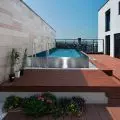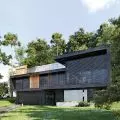The article is from A&B issue 6|23
In the uneven fight against global warming, one of the main actions is to reduce carbon emissions. Studies have shown that the construction sector accounts for half of global raw material consumption and energy produced, so architectural experimentation in the context of energy efficiency or self-sufficiency can make a real contribution to reducing and slowing the effects of climate change. In the construction sector, almost everything starts with a design, so it is on the shoulders of architects and builders that much of the responsibility for what, how and with what material is created, irreversibly changing the appearance of our planet.
What kind of architecture is being created? Well, the kind that the law allows. And building laws vary from country to country, although we have one Earth and on a global scale climate change is our common problem. Many countries, especially highly developed ones, have already implemented strict requirements for the energy efficiency of buildings and urban planning solutions, and at the same time it is these countries that have contributed most to environmental degradation in the past with their dynamic development. But it's not time to look for the guilty, it's time to take care of the future and develop solutions.
Heliotrope designed by Rolf Disch is located in Freiburg—when it was built, in 1994, it was the first house in the world to produce more energy than it consumed
Photo: Andrewglaser © Wikimedia Commons © CC B4-SA 3.0
Ideas vary: rational ones and the crazier ones. Which ones are changing the world? The history of inventions and crossing human barriers proves that usually the latter. Following the principle of „if something is stupid, but works, it's not stupid,” I will present some controversial examples. First up is the Heliotrope, a residential house designed by Rolf Disch. It was built in Freiburg between 1993 and 1994, and was initiated by the Fraunhofer ISE Institute for Solar Energy Systems. It was built as a self-sufficient solar house—the first house in the world to produce more energy than it can use. Under the right weather conditions, it can generate up to six times more electricity than its own demand. It rotates about a vertical axis in such a way that it can follow the sun. An internal rotating mechanism is responsible for this, which azimuthally tracks the movement of the sun, so that the building is always facing it, and with it the solar panels mounted on the roof. The entire form of the building is subordinated to energy benefits. It has a fully glazed south facade, a roller shutter system for regulating interior insulation and photovoltaic cells on the roof.
Maybe none of the mentioned elements cause a great sensation now, but when it was built, it did not resemble an ordinary residential house. The house has no connection to the external electricity or gas grid, and there is no fuel oil tank. The building is still standing today, lived in by the designer himself, who is a pioneer in the use of solar energy in architecture and an environmental activist. The building is for rent—one can experimentally stay there and take advantage of its „otherness,” and there is also the possibility to control the house and the panels independently, should someone not like living in a rotating house. In Germany, in addition to this prototype, there are two more twin buildings: an exhibition building for the Hansgrohe company in Offenburg and a laboratory( dentallaboratory ) in Hilpoltstein, Bavaria.
The building was constructed from materials commonly considered trash—although it looks a bit primitive it is technologically adapted for passive and green energy generation
photo: © courtesy of Earthship global
Are you familiar with the quadrant house by Robert Konieczny? I was immediately reminded of this moving terrace. A huge regular white block of a house on a rectangular plot and a platform that travels in an arc from one end to the other. It's a building completed for a private investor in 2019, serving as a single-family residential house with a floor area of 558 square meters. As I read in the author's description on the KWK Promes office website, „The investors wanted a house that reacts to the position of the sun, so we used the motif of the quadrant—an ancient instrument used to determine the position of the stars. We designed a terrace that reacts to the sun and follows its movement: it gives the residents sitting in its space shade and pleasant ventilation, depending on the season it regulates the amount of sunlight in the spaces it adjoins—in summer giving the desired shade, and in winter letting more sun into the interior.” Further on, you can read about the technical aspects of such an idea: „The movement of the terrace and its speed is adapted to the wandering of the sun. The drive system is fully automated and has advanced safety sensors—if it encounters an obstacle, the terrace stops, making it completely safe to use. However, for functional reasons, manual control is also possible. The terrace has been programmed to be in constant motion during the day, so that natural grass grows underneath.” There are gigantic costs and advanced technologies behind it.
The structure, located in the middle of nowhere near New Mexico, has been given the symbolic name "Ship Earth"—and is currently open to the public
photo: © courtesy of Earthship global
Let's go back to the crazy experimenters. One of them is Michael Reynolds, better known as Garbage Warrior. He's an architect from the University of Cincinnati who in the 1970s took the initiative to build apartment buildings near New Mexico. The originality of this project was that the building blocks were objects and materials considered by consumer civilization to be completely useless or worn out. These included no longer needed tires or aluminum cans or soda bottles. This is where the architect's nickname came from: Garbage Warrior.
Architect Michael Reynolds, better known by his nickname Garbage Warrior, posing in „Earthship”
Photo: © courtesy of Earthship global
Self-sufficiency wasn't just about sourcing materials in this way, but also about technologically preparing the building for passive and green energy generation, ensuring independence. Those interested in the topic are referred to a documentary film directed by Oliver Hodgesimply titled "Garbage Warrior." The documentary shows the struggle of an unremarkable architect and a hippie construction crew to introduce radically different ways of building and, going further, a different lifestyle. The self-sufficient building is located in Taos, in the middle of nowhere, given the symbolic name „Earthship.” „Earthship” can now be viewed, there are ticketed guided tours. The facility is no longer furnished as before (like a house) because it has been adapted for public education functions and opened to the public.
The status of Arcosanti's construction as seen in a Google satellite image from 2023
photo: © Google Maps
Another architect who firmly believed in his unusual idea and was considered by many to be a madman was Italian Paolo Soleri, creator of the term „arcology” and the concept associated with it. An arcology, to quote from Wikipedia, is „a structure or settlement with an unusually high population density, often reaching heights of more than a kilometer. The term was coined by architect Paolo Soleri as a combination of "architecture” and „ecology.” So far, these structures have not progressed beyond the phase of designs and theoretical considerations and experiments conducted in Arcosanti, central Arizona. Popular in science fiction, they are presented as a solution to the problems of overpopulation and environmental degradation because they reduce cities' need for land and resources, although they feature higher-than-usual population densities and major modification of a specific area. While most cities expand only horizontally, occupying larger and larger tracts of land, arcologies are somewhat more 'three-dimensional' structures."
The aforementioned Arcosanti is an experiment to which Soleri, as an architect and builder, devoted most of his professional life (he died in 2013), and yet only part of the plan was realized. The plan was to create a city for several thousand residents. The work on this project of self-sustaining architecture involved a group of people, including volunteers, whom the architect convinced of his idea. In the vicinity of Cordes Junction, Arizona, on Interstate 17 north of Phoenix, construction of this large-scale arcological structure is still underway, but work is progressing very slowly due to a chronic lack of finances for this purpose.
An archival photo showing Arcosanti builders in the early stages of construction
photo: © The Cosanti Foundation
Today, the project is seen as a vestige of one of history's many attempts to heal urbanism, although Arcosanti is still developing construction technologies to erect arcological buildings. The Cosanti Foundation is active on site, educating, providing tours and overseeing the ongoing work. The foundation's website reads: "this mission is as relevant today, if not more so, than when it began. As the world's population continues to grow, the effects of urban sprawl are compounded, and the Earth faces the challenge of supporting humanity with limited natural resources and climate change. As a result, the Council has recommitted itself to continuing the Cosanti Foundation 's mission based on advocacy and becoming an even more important voice in the conversation on sustainable urban development around the world."
There are still experts who believe that arcologies will be commonplace in the future as a way to counteract the absorption of too much land by urbanization processes, because they are based on the idea of sensible use of the Earth's surface. Various ways of densifying urban structures and making them "three-dimensional" are being considered to stop the two-dimensional distribution of urbanization. The concept emphasizes more efficient and economical use of resources and the concentration of urbanized space for environmental protection.
The Cosanti Foundation administration building
Photo: © The Cosanti Foundation
For the time being, however, arcologies appear mainly in fictional literary and film representations or computer games. And if as projects—then only on paper. Soleri himself left many of them, in the form of conceptual sketches. He tried to convince people of his idea at any lectures or exhibitions. It should be mentioned that he was at the same time a man with his feet firmly on the ground and left many completed projects for which he is appreciated, such as the Dome House in Cave Creek or the bridge in Scottsdale.
A completely different city from Arcosanti is Drop City. Its creators are closer to the aforementioned Garbage Warrior. The building blocks used such materials as recycled wood, fragments of car sheets or caps. This allowed for virtually no-cost construction. The initiative was quite popular, and people who could not get personally involved in the project eagerly provided materials to support the project and see what could be made of them. The shape of the buildings themselves was taken from the structures of Buckminster Fuller's geodesic domes, using the experimental solutions of Steve Baer (a pioneer in passive solar technology).
One of the first „houses” created in Drop City built by the creative community; photo from 1967
photo: © dropcitydoc
The creators and residents of Drop City had little experience in building, but were full of faith in their idea and determined to make it a reality. The originators and founders of this community of artists were four friends from the University of Kansas and the University of Colorado: Gene Bernofsky (Curly), JoAnn Bernofsky (Jo), Richard Kallweit (Lard) and Clark Richert (Clard). The art students and filmmakers, who in 1960 bought nearly 3 acres 6 kilometers north of Trinidad, in southeastern Colorado, wanted to create Drop Art creative workspaces, a continuation of the art concept they had developed earlier at the University of Kansas.
The sample dome was created from materials such as recycled wood, fragments of car sheets, etc.
photo: © dropcitydoc
The idea fell on fertile ground and the crazy times of the hippie movement. The originators were quickly joined by other artists from different fields and a creative community began to build. Drop City was so popular that it gained international fame and imitators. Over time it became overpopulated and eventually the community decided to say goodbye to the place. After 1973, it became an extinct city, but continues to inspire alternative communities.


















































